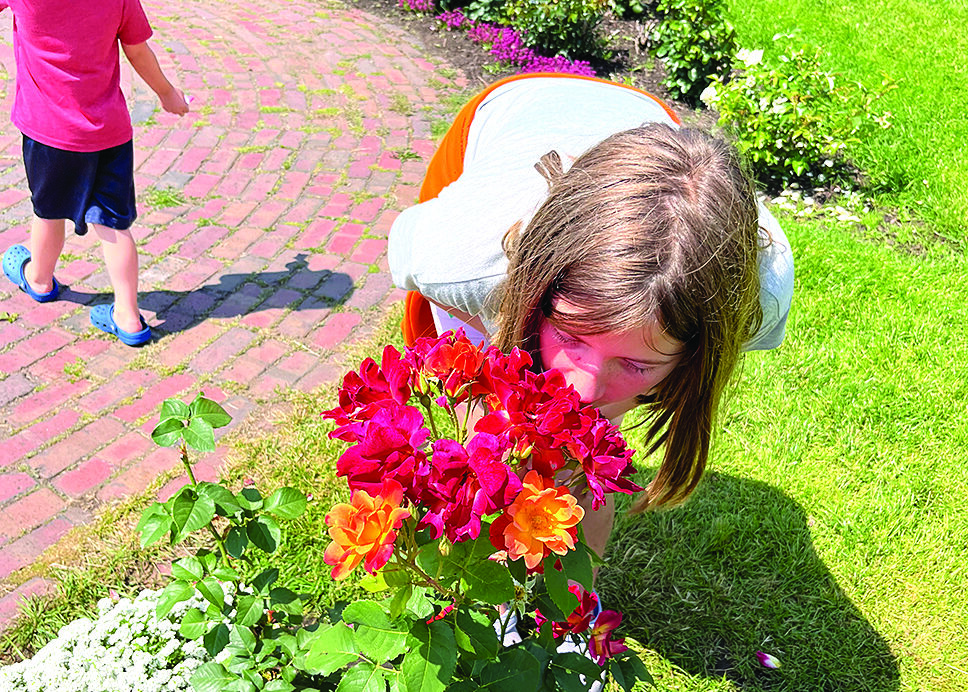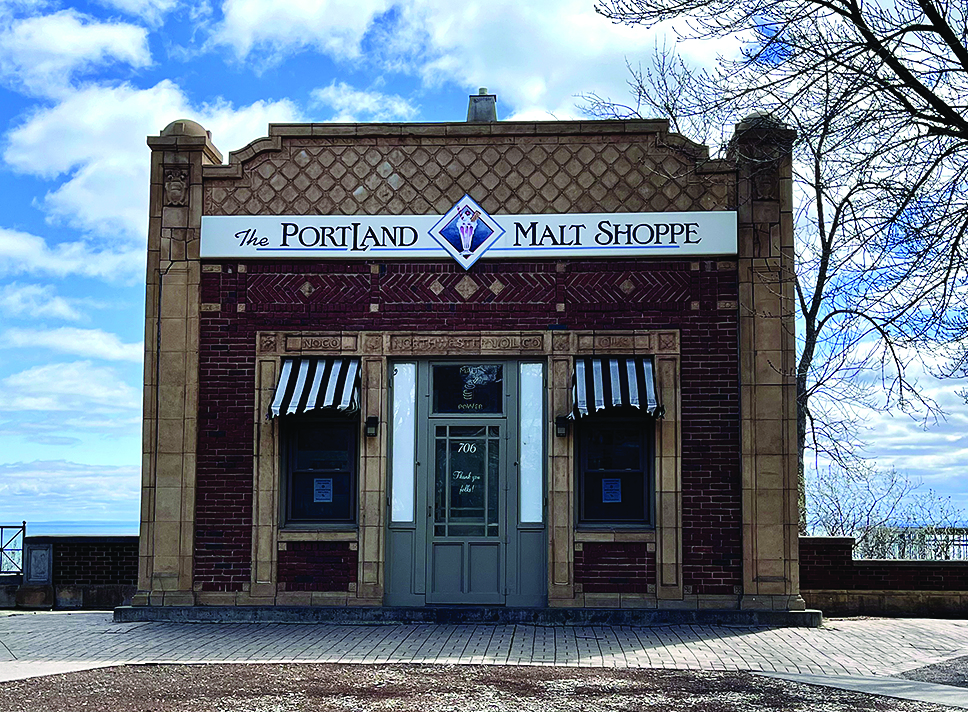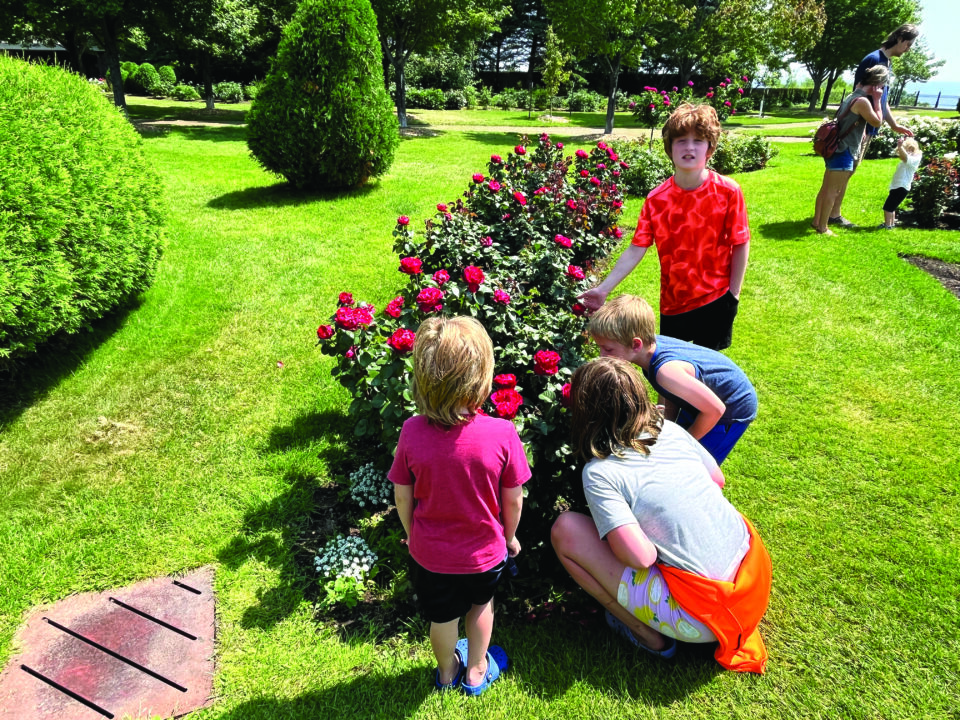I have four grandchildren, Clara, Michael, Evan, and Charlie, ages 12 to 5. During the summer months when I take care of them, I look for activities we can all enjoy. I call them “our adventures,” and if possible, I like them to include the outdoors, movement, learning, and fun. With four grandchildren, it’s nice if the activities are inexpensive, or better yet free. Nearby bathrooms are a big plus.
Last summer at the end of July, we went to the Duluth Rose Garden, followed by a stroll along Duluth’s Lakewalk to the PortLand Malt Shoppe.
I parked in the lot at Leif Erikson Park, located at 1301 London Road. Visitors enjoy free parking for up to three hours (April 1 to October 31), and nice restrooms are available. The Duluth Rose Garden, which is part of Leif Erickson, overlooks Lake Superior. On the day we visited, the sun tossed sparkles on the rippling water, while a gentle breeze off the lake kept us cool.
Charmed by colorful swaths of blooms, my grandchildren swarmed up and down the gracefully curved rows of roses. With over 2,500 roses in 275 varieties, they had lots to see and smell. “Hey, Nana, I didn’t know roses came in orange!” Michael, 10, said. It’s one of his favorite colors.
We strolled on the grass, admiring roses and other flowers planted in a nutrient-rich bed of soil, which is six feet deep and rests on a layer of concrete that forms the ceiling of a four-lane tunnel. Underneath us, traffic zoomed at 50 mph. People who visit the Duluth Rose Garden may not realize a freeway tunnel runs underneath it.

In the early 1990s, a freeway extension usurped the previous rose garden, and the roses had to be removed. There was nowhere to store them, but rather than throw them away, 2,500 rose plants were given to Duluth residents. However, not all of the plants were given away. Some of the rose species were descended from plants dating back to the 1600s and 1700s. Those old varieties were planted in another part of the city, then replanted with the new varieties in the Duluth Rose Garden after the freeway was completed in 1994.
Because a tunnel runs under the garden, radiant heat from the earth is interrupted, and the roses need help to survive Duluth’s cold winters. In the fall, volunteers dig small trenches, tip rose bushes into them, then cover the bushes with dirt. The bushes have cords tied to them, and in the spring volunteers raise the roses by pulling the cords. Carol Borich, co-president of the Lake Superior Rose Society, said about 1,500 roses are tipped and raised each year.
My grandchildren bent their smiling faces toward silky petals in shades of pink, yellow, red, and orange, and inhaled deeply. After smelling various roses, Clara, 11, stood upright and said, “Nana, different roses have different smells!” She was smelling the old garden roses planted in a semi-circle along an open expanse of grass.
Borich tells people to “bring your nose” because old garden roses have lots of fragrance. She explained they have a short season but “bloom like mad for a month.” To Borich the different varieties of old roses smell like licorice, cloves, honey, or various fruits. But she points out people experience the same aromas differently.
Normally, mid-June to mid-July is the best time to enjoy the old garden roses. But during the winter of 2022-2023, Lake Superior froze, causing a cold spring, which delayed rose blossoms by two weeks. So, even at the end of July, Clara still experienced a smorgasbord of scents.

Clara moved to another section of roses and kept sniffing. “Some of these don’t have any smell,” she said. The unscented roses are modern shrub roses, which are hardier and easier to grow. They are disease resistant, so they don’t require synthetic chemical sprays. Plus, they bloom from the second or third week of June into September, providing continuous color in the Duluth Rose Garden, but they don’t smell like your grandparents’ roses.
Charlie, 4, buzzed like a jolly bumblebee, visiting as many roses as he could, repeatedly calling out, “Nana, look at this beautiful flower,” as he admired each one. I thought he might be the grandchild least interested in roses, but he was gobsmacked by their beauty. He wasn’t even distracted when his brother Evan, 6, kept asking, “When are we going to get ice cream?” Evan enjoyed the roses but didn’t feel the need to greet each one—not when the PortLand Malt Shoppe was our next destination.
Eventually, our eyes and noses satisfied, we headed down the Lakewalk to the ice cream shop, hoping to tickle our tastebuds. Duluth’s Lakewalk, almost 8 miles long, runs from Bayfront Park to Brighton Beach. Our journey covered about 2,000 steps or .7 miles, doable for children four or older. Because bicycles and electric scooters share the Lakewalk, I reminded my grandchildren to stay on the right-hand side of the path.
Cobbled walkways, stone bridges, and hidden paths delighted us. Our walk started along a red-brick path edged with a black wrought-iron fence, which overlooks Lake Superior. Soon, Evan and Charlie spotted a graceful stone and cement bridge, spanning a set of railroad tracks. They pointed, quivering with anticipation, and asked, “Can we walk across that?”
Shortly, after crossing the bridge and descending a set of stairs, we encountered the Leif Erikson amphitheater. Completed in 1928, it was built for pageants, concerts, and community events, and is still used today. Made of stone and slate, it’s a semicircle stage with a tower on each side. Tourists are welcome to explore it. My grandchildren frolicked across the stage and ducked in and out of the towers, enjoying their 15 minutes of theatrical make believe.

Before reaching the ice cream shop, Michael spotted a dirt path to the left of the Lakewalk. Hemmed in by trees and bushes, it beckoned my four explorers, and one-by-one they disappeared into the foliage. They climbed the small hill, walked parallel to the Lakewalk for less than two minutes, then re-emerged with happy faces. (Note, because a different path at the top of the hill leads to the lakeshore, small children should be accompanied by an older sibling or adult.)
We continued along the Lakewalk until we reached Mile Marker 1 by a set of stairs, which we climbed. A walkway took us back over the railroad tracks and up to street level, right next to the PortLand Malt Shoppe.
The Malt Shoppe began life as a gas station in 1921. The Northwestern Oil Company name can still be seen on the top of the building. In the 1970s, the station became a dress boutique. It then became an ice cream shop in 1989.
PortLand offers 14 flavors of delicious ice cream and lots of tasty toppings. Patrons can order malts, floats, and sundaes, or ice cream scooped into waffle, sugar, or cake cones. Because the Rose Garden and parking were free, I splurged on ice cream.
We sat at a nearby picnic table. Clara, Evan, and Charlie ate sundaes topped with their favorite sauces, and Michael licked ice cream from a sugar cone. I slurped a mint chocolate-chip malt topped with whip cream and a vanilla wafer, hold the maraschino cherry, please. We looked out upon a calm, sparkling Lake Superior and relished the sweet ending to our most recent adventure.




